Toyota Chaser
| Toyota Chaser | |
|---|---|
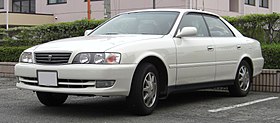 Toyota Chaser Avante | |
| Overview | |
| Manufacturer | Toyota |
| Production | 1977–2001 |
| Body and chassis | |
| Class | |
| Chronology | |
| Predecessor | Toyota Mark II GSS[1] |
| Successor | Toyota Verossa |
The Toyota Chaser (Japanese: トヨタ・チェイサー, Hepburn: Toyota Cheisā) is a mid-size car produced by Toyota. In the beginning, Chasers were four-door sedans and hardtop sedans; a two-door coupé was available only for the first generation. It was introduced on the 1976 Toyota Corona Mark II platform and was only available at Japanese Toyota Vista Store dealerships, and was later joined with the Toyota Cresta. The Chaser was produced for six generations, and production ceased in 2001 when it was merged with the Cresta to form the short-lived Verossa.
The Chaser has been known as Toyota's 'triplet sedans' because it shares the same chassis with the Cressida, Mark II, and the Cresta sold at different dealership sales channels. The Chaser and its platform sisters are considered a class below the Crown, allowing Toyota to offer a sedan with similar levels of luxury content yet offering buyers lower tax liability and a more sporty image with a slightly shorter body length.
As the series and generations offered ever-increasing engine displacement, the Chaser's performance reputation benefited. The addition of turbochargers and superchargers to growing engine displacement was offset by the fact that the Japanese Government taxed and regulated vehicle emission results. Larger engines offered more luxury, convenience, and suspension improvements as the generations progressed.
The Chaser represented a marketing approach of providing a luxurious version of older, established vehicles by offering a four-door hardtop body style combined with luxury amenities, powerful engines, and enhanced ride quality and performance. Similar vehicles offered were the Corona EXiV, Carina ED, Corolla Ceres and Sprinter Marino. This was offered during the early 1980s before "the bubble economy" took effect, and sales diminished.
X30-X40 series (1977-1980)[edit]
| Toyota Chaser | |
|---|---|
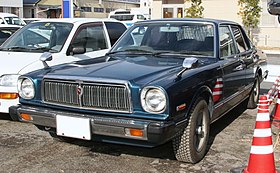 Toyota Chaser 2000 XL sedan | |
| Overview | |
| Model code | X30 X40 |
| Production | 1977–1980 |
| Assembly | Toyota, Aichi, Japan (Motomachi plant)[2] |
| Body and chassis | |
| Body style |
|
| Layout | Front engine, rear-wheel drive |
| Related | |
| Powertrain | |
| Engine | |
| Transmission | |
| Dimensions | |
| Wheelbase | 2,645 mm (104.1 in) |
| Length | 4,500–4,530 mm (177.2–178.3 in) |
| Width | 1,670–1,680 mm (66–66 in) |
| Height | 1,390–1,415 mm (54.7–55.7 in) |
| Curb weight | 1,050–1,175 kg (2,315–2,590 lb)[3] |
The Chaser was first produced in July 1977 with chassis codes X30, X31, X40 and X41, and evolved from the X20 generation Mark II GSS hardtop coupe.[1] They were powered by the four-cylinder 1.8-liter 3T-U, 13T-U and 2-liter 18R-U, and the six-cylinder 2.0 L M-U/EU engines – all single cam engines tuned for economy and clean emissions rather than performance. The Chaser is a lightly redesigned Toyota Mark II, with a wider front grille and without parking lights. The Chaser also has taillights of a different design.[1] Unlike the Mark II, there were no station wagons or commercial models offered. This was the only Chaser offered as a 2-door, with the 2-door option being replaced by the Toyota Soarer.
To provide buyers with a luxury sports sedan while minimizing tax consequences, the vehicle was limited to an engine size at 2000 cc as well as dimensions under 4.7 m (15.4 ft) long, 1.7 m (5.6 ft) wide, and 2 m (6.6 ft) high. Engine displacements of 1.8 L and 2.0 L were offered to keep the annual road tax bill affordable to Japanese buyers. The Chaser was offered as a competitor to the Nissan Skyline coupé and sedan. The performance image was shared with the Toyota Celica Camry and Toyota Celica XX, introduced in 1978, and shared the 2.0 L M-U/EU Inline-six engine from the Celica XX.
The Celica XX was exclusive to Toyota Corolla Store with the Celica Camry, then August 1980 the Celica Camry was also added to Toyota Vista Store with the more upscale Chaser.[4]
- Hardtop coupe trim packages
- SG Touring, SGS, SXL, GS, XL
- Sedan trim packages
- SG Touring, SGS, GS, XL, DX

X60 series (1980–1984)[edit]
| Toyota Chaser | |
|---|---|
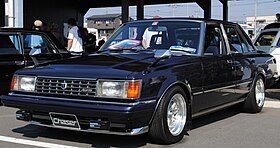 Toyota Chaser Avante sedan (GX61) | |
| Overview | |
| Model code | X60 |
| Production | October 1980[5] – 1984 |
| Assembly | Susono, Shizuoka (Higashi Fuji) (Kanto Auto Works)[6] |
| Body and chassis | |
| Body style |
|
| Layout | Front engine, rear-wheel drive |
| Related | |
| Powertrain | |
| Engine | |
| Transmission | |
| Dimensions | |
| Wheelbase | 2,645 mm (104.1 in) |
| Length | 4,640 mm (183 in) (hardtop) 4,480 mm (176 in) (sedan) |
| Width | 1,690 mm (67 in) (hardtop) 1,670 mm (66 in) (sedan) |
| Height | 1,390 mm (55 in) (hardtop) 1,375 mm (54.1 in) (sedan) |
| Curb weight | 1,055–1,220 kg (2,326–2,690 lb)[8] |
The X60 Chaser began sales October 1980,[5] with the addition of the new 2.0-liter six-cylinder multi-port fuel injected 1G-EU single cam gasoline engine and a 2.2 L four-cylinder L-series diesel engine. The four-cylinder engines were upgraded to fuel injection early on.
Body styles offered were a four-door sedan or 4-door pillared hardtop, and no longer offered the 2-door hardtop, which was replaced by the all-new luxury coupe Toyota Soarer. The top trim package "Avante" was introduced and remained until the Chaser was discontinued in 2001. The hardtop and sedan came with individual trim packages, and the hardtop was the most desirable, while the XL and DX had flat bumpers that shortened their overall length.[5] The front suspension consisted of MacPherson struts with a lower control arm, and the rear suspension used a semi-trailing arm with coil springs and separately installed shock absorbers.[5] Fourteen-inch aluminum alloy wheel was standard on the Avante and SG Touring trim packages while thirteen-inch steel wheels were installed on other trim packages.[5]
The cloth-only interior in several varieties offered a power-adjustable driver's seat with lumbar support, while the rear seat had a fold-down armrest and a 60/40 split rear seatback that could accommodate longer items. Optional items included several sound system choices, including an AM/FM stereo cassette with integrated equalizer, a trip computer, power windows with standard equipped express down for the driver's window, glass sunroof, cruise control, digital clock with an alarm feature, a rear window wiper with electric defrost, headlight washers for the halogen headlights, and three-point seatbelts for front and rear passengers with ELR safety lock-down in case of a collision.[5]
This generation saw the introduction of a new companion called the Cresta to compete with the Nissan Leopard, while the Chaser continued to be the alternative to the Skyline.
In August 1982, the 2.0 L 6–6-cylinder 1G-GEU twincam engine was added, and the Celica Camry, which was offered at Toyota Corolla Store and Toyota Auto Store, was renamed the Toyota Vista and Toyota Auto Store dealership was renamed for the Vista.[5][9]
- Hardtop trim packages
- Avante, SG Touring, SXL, GT, XG, XL
- Sedan trim packages
- Avante, SG Touring, SXL, GT, XG, XL, DX
- Diesel Sedan trim packages
- XL-Extra, XL, DX

X70 series (1984–1988)[edit]
| Toyota Chaser | |
|---|---|
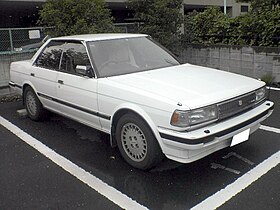 Chaser GT Twin Turbo (GX71) | |
| Overview | |
| Model code | X70 |
| Production | 1984–1988 |
| Assembly | Susono, Shizuoka (Higashi Fuji) (Kanto Auto Works)[10] |
| Body and chassis | |
| Body style | 4-door pillared hardtop sedan |
| Layout | Front engine, rear-wheel drive |
| Related | |
| Powertrain | |
| Engine | |
| Transmission | |
| Dimensions | |
| Wheelbase | 2,660 mm (105 in) |
| Length | 4,630 mm (182 in) 4,560 mm (180 in) (XL) |
| Width | 1,690 mm (67 in) |
| Height | 1,385 mm (54.5 in) |
| Curb weight | 2,712 kg (5,979 lb) |
This series first appeared in August 1984, and the hardtop body style was the only one offered. This car's exterior dimensions were slightly smaller than those of the sister cars, Mark II and Cresta. Still, the Chaser was more performance-oriented while maintaining the Cresta's advanced features and luxurious interior. In October 1985, Mark II / Cresta 1G-GTEU vehicles with a "GT twin turbo" appeared. Disc brakes are larger in diameter, and it was now equipped with bucket seats, borrowed from the Supra (A60) to distinguish that the Chaser was a performance sedan and set it apart from the luxurious Cresta.[5]
Some enhancements were introduced in August 1986. The 1G-GEU engine received various improvements, while the LPG-powered engine was changed to the 3Y-PU. As for appearance, larger bumpers and a new front grille accompanied substantial changes to the equipment. The early type rear combination lamps were kept with minor revisions. The TEMS installation shared the same settings used in the 1986 Soarer and 1986 Supra (A70) to remain consistent with its performance-focused market position. The "GT TWIN TURBO S" was only available with a 5-speed manual transmission.[5]
In January 1987 a special edition "Lordly" was released, in May 1987 the special edition "Chaser Avante" was released. In September 1987 new versions of the 2L and 2L-T diesel engines complying with the 1986 car emissions standards were introduced. January 1988 special edition "Avante Supra" released as a companion to the updated, third-generation Supra (A70). In April 1988, a special edition of "XG-Extra with Auto Air Conditioner" was launched.[5]
- Trim packages (2.0L and 1.8L)
- Avante (2.0L), Avante Turbo (2.0L), Avante TwinCam (2.0L), GT Twin Turbo (2.0L), SXL (2.0L), XG (1.8L), XG-Extra (1.8L), XL (1.8L)
- Diesel Sedan trim packages
- XG (turbodiesel), XL (diesel and turbodiesel)
X80 series (1988–1992)[edit]
| Toyota Chaser | |
|---|---|
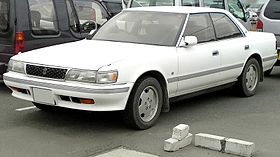 1990 Toyota Chaser Avante G | |
| Overview | |
| Model code | X80 |
| Production | 1988–1992 |
| Assembly | Susono, Shizuoka (Higashi Fuji) (Kanto Auto Works)[11] |
| Body and chassis | |
| Body style | 4-door pillared hardtop sedan |
| Layout | Front engine, rear-wheel drive |
| Related | |
| Powertrain | |
| Engine | |
| Transmission | |
| Dimensions | |
| Wheelbase | 2,680 mm (106 in) |
| Length | 4,690 mm (185 in) |
| Width | 1,690 mm (66.7 in) |
| Height | 1,370 mm (54.1 in) |
| Curb weight | 1,420 kg (3,131 lb)[12] |
In August 1988, the X81 series of Chasers were introduced to the Japanese market. The GT Twin Turbo model was now the most powerful variant, powered by the 1G-GTE engine putting out 210 PS (154 kW; 207 hp) at 6200 rpm. The Avante G model was the highest special edition model in terms of equipment. In August 1989, two more models were added to the Avante lineup: the Avante G-L, an even more luxurious model of the Avante G (which was already highly equipped for a car of the time), and a new Avante G with a 3.0 L normally aspirated 7M-GE engine replacing the 2.0 L supercharged 1G-GZE from the previous model.[5]
This generation introduced a visual distinction: the Chaser was only available as a pillared hardtop, the Cresta was only a sedan, and the Mark II offered both body styles.[5] Exterior dimensions increased to the maximum limit under Japanese Government dimension regulations and now matched the Crown.
The suspension continued to offer MacPherson struts for the front, but the rear suspension was upgraded to a new double-wishbone design. The optional TEMS electronic shock absorbers and specially modified MacPherson struts were available on the top-level trim package Avante G. The new rear suspension was shared with the Soarer.[5] The Cresta and Chaser were no longer the top-level cars at Toyota Vista Store when the Toyota Aristo was introduced in 1991, and combined with the economic effects starting with the eventual collapse of the "bubble economy", sales were affected.

In August 1990, major revisions were made to the Chaser lineup, and some of the models received entirely new engines. The top-range models, Avante G and GT Twin Turbo received the new 2.5L 1JZ engine, the same engine installed in the JZA70 Supra, although the 3.0L Avante G remained. The Avante G 2.5L received a normally aspirated 1JZ-GE engine with a maximum 180 PS (132 kW; 178 hp) at 6000 rpm, while the GT Twin Turbo received the parallel twin-turbo 1JZ-GTE capable of 280 PS (206 kW; 276 hp) at 6200 rpm, the maximum horsepower allowed under Japanese regulations.[5]
- Trim packages (3.0L, 2.5L, 2.0L and 1.8L)
- Avante G (3.0L), Avante G (2.5L), Avante G (2.0L), GT Twin Turbo (2.0L), GT Twin Turbo (2.5L), Avante TwinCam24 (2.0L), Avante (2.0L), SXL (2.0L), Raffine (1.8L), XG (1.8L), XL (1.8L)
- Diesel Sedan trim packages
- XL (turbodiesel)
X90 series (1992–1996)[edit]
| Toyota Chaser | |
|---|---|
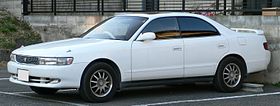 | |
| Overview | |
| Model code | X90 |
| Production | October 1992 – September 1996 |
| Assembly | Susono, Shizuoka (Higashi Fuji) (Kanto Auto Works)[13] |
| Body and chassis | |
| Body style | 4-door pillared hardtop sedan |
| Layout | |
| Related | |
| Powertrain | |
| Engine |
|
| Transmission | |
| Dimensions | |
| Wheelbase | 2,730 mm (107 in) |
| Length | 4,750 mm (187 in) |
| Width | 1,750 mm (68.9 in) |
| Height | 1,390 mm (54.7 in) |
| Curb weight | 1,450 kg (3,197 lb)[14] |
In October 1992, the X90 Chaser replaced the previous X81 Chaser. It had a larger body, better handling, and more engine power. The body was curvier, and the car was significantly longer. The Chaser lineup was largely carried over from the X81 Chaser except the GT Twin Turbo, which was abolished and replaced by the new Tourer V. The top-of-the-line Avante G model received a 220 PS (162 kW; 217 hp) natural aspirated 2JZ-GE, the next evolution of the JZ series of engines after the 1JZ. Exterior dimensions exceeded the maximum limit under Japanese Government dimension regulations, and buyers now paid more yearly taxes, contributing to diminished sales.
The Tourer V was equipped with the 1JZ-GTE engine, the most potent offering. Manual transmissions were optional for all engine offerings, from the 1.8-liter 4S-FE[15] and 2.4 turbodiesel 2L-TE up through the 2.0-liter 1G-FE and 2.5-liter 1JZ-GE straight-sixes.[5] The Tourer S trim received the non-turbo 1JZ-GE. In September 1992, the Tourer models received equipment upgrades, although not to the level of the Avante G, and their prices were correspondingly higher. The traditional MacPherson strut front suspension added double wishbone technology with this series.
Permanent all-wheel-drive, called i-Four, was offered as an option in 1993 to stay competitive with the Nissan Skyline GTS sedan. The system typically provided 30 percent to the front and 70 percent to the rear wheels, incorporating a center differential lock feature. It was described as a safety feature linked to the anti-lock brakes, electronically controlled transmission, and electronic fuel injection. It was offered on the Avante Four trim package.
After the X80 generation, the export-market Cressida retired, and the X90 (in Mark II, Chaser, or Cresta guises) was only offered in the Japanese home market. Each member of the Mark II family supposedly had different characteristics—the Chaser was a pillared hardtop geared towards sporty driving, the Cresta was a stylish opulent luxury sedan, and the Mark II was a traditional luxury sedan.
- Trim packages (3.0L, 2.5L, 2.0L and 1.8L)
- 3.0 Avante G, 2.5 Avante G, 2.5 Tourer V, 2.5 Tourer S, 2.5 Avante, 2.5 Avante Four, 2.0 Avante, Raffine (1.8L), XL (1.8L)
- Diesel Sedan trim packages
- Raffine, XL (turbodiesel)
X100 series (1996–2001)[edit]
| Toyota Chaser | |
|---|---|
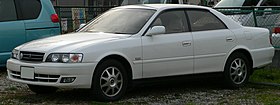 | |
| Overview | |
| Model code | X100 |
| Production | 1996–2001 |
| Assembly | Miyawaka, Fukuoka (Miyata) (Toyota Motor Kyushu)[16] |
| Body and chassis | |
| Body style | 4-door pillared hardtop sedan |
| Layout | |
| Related | |
| Powertrain | |
| Engine | |
| Transmission | |
| Dimensions | |
| Wheelbase | 2,730 mm (107 in) |
| Length | 4,760 mm (187 in) |
| Width | 1,760 mm (69.1 in) |
| Height | 1,400 mm (55.1 in) |
| Curb weight | 1,450 kg (3,197 lb)[17] |

In September 1996, the X100 Chaser replaced the X90 Chaser. The product lineup consisted mostly of Avante and Tourer trim, with the Avante as the luxury model (with more interior accessories) and the Tourer as the sporty model (with large 16-inch wheels). Toyota's VVTi, the company's version of variable-valve timing, was added to the 1JZ engines; they were also upgraded to have more torque, since they had already reached the agreed voluntary limit set by Japanese Automobile Manufacturer's Association regarding horsepower. The 1JZ-GTE was powered by a single turbo configuration instead of the twin turbo of its predecessors.
New to the lineup was the Avante Four and the Avante Four G Package, which was the Avante 2.5 L installed with i-Four all-wheel-drive. These cars were only available with a 4-speed electronically controlled automatic transmission. The Tourer V and the automatic-only Avante G 3.0 L (2JZ) models had the option of electronic control flex lockup attaching 4-speed automatic (intelligent) (ECT-iE) transmission, besides the ECT-E automatic in the lower-end models.[5]
In 1997, the lineup was updated. The XL was powered by the 2.4 L 2L-TE turbodiesel engine, while the 1G-FE engine powered the Tourer 2.0 L, rated at 140 PS (103 kW; 138 hp) at 5,600 rpm.[18] These models were only sold with the 4-speed electronic control type (ECT) automatic transmission.[5]
In mid-late 1998, the base Tourer model received the optional manual gearbox. An AWD option was added to the 2.5L Avante models; the Four G Package received a higher special-edition interior. Additionally, the Chaser received a facelift, with the most significant changes to the rear tail lights. Other changes included new fog lights with a slightly redesigned front bar to accommodate them, different interior fabric, a 3-spoke steering wheel instead of 4 spokes, orange gauge lighting instead of white, and a grille with 2 horizontal bars instead of 3. The Chaser continued to be offered as the second-level sedan below the Toyota Aristo, and in 1998 Toyota Vista Store locations were renamed NETZ Store.
The Chaser was discontinued in June 2001.[19] It was replaced with a new model called the Verossa which shared the same model code. The Cresta suffered the same fate, but the Mark II continued for another generation (X110) before it was also discontinued. In 2004, the all-new X120 Mark X was introduced in Japan, incorporating many characteristics of the Chaser and the Cresta.
- Trim packages (3.0L, 2.5L, 2.0L and 1.8L)
- 3.0 Avante G, 2.5 Avante G, 2.5 Tourer V, 2.5 Tourer S, 2.5 Avante, 2.5 Avante Four, 2.0 Avante, 2.0 Tourer
- Diesel Sedan trim packages
- Avante, XL (turbodiesel)
Motorsports[edit]

X100 Chasers took part in the Japanese Touring Car Championship in 1997 and 1998. The car did not manage to win a race in its debut season, while the following year, when other manufacturers had left the JTCC, it won the title with Masanori Sekiya and TOM'S. The Chaser became famous in drifting events,[20] due to its traditional front-engine, rear-wheel-drive layout, and vehicles without AWD installed are more sought after. Numerous Toyota Chasers, especially the later X90s and X100s, have been modified for use in drift.[21]
References[edit]
- ^ a b c Fujimoto, Akira, ed. (January 1978). "Japanese Cars 1978". Title: Car Styling Quarterly (21). Tokyo, Japan: San-ei Shobo Publishing: 57.
- ^ "TOYOTA MOTOR CORPORATION GLOBAL WEBSITE | 75 Years of TOYOTA | General Status of Plants in Japan | Motomachi Plant". www.toyota-global.com.
- ^ "Toyota Chaser 1st". Toyota. Retrieved 14 September 2020.
- ^ 別冊CG: 自動車アーカイヴ 80年代の日本 [Car Graphic: Car Archives Vol. 11, '80s Japanese Cars] (in Japanese), Tokyo: Nigensha, 2007, p. 47, ISBN 978-4-544-91018-6
- ^ a b c d e f g h i j k l m n o p q r "75 Years of Toyota | Vehicle Lineage | Chaser". Japan: Toyota. 2012. Retrieved 11 April 2020.
- ^ "TOYOTA MOTOR CORPORATION GLOBAL WEBSITE | 75 Years of TOYOTA | General Status of Plants in Japan | Affiliates (Toyota wholly-owned subsidiaries)-Toyota Motor Kyushu, Inc". www.toyota-global.com.
- ^ a b 自動車ガイドブック [Japanese Motor Vehicles Guide Book '82~'83] (in Japanese), vol. 29, Japan: Japan Automobile Manufacturers Association, 1982-10-20, p. 127, 053-820029-3400
- ^ "Chaser 2nd (catalogue)". Toyota.co.jp. Retrieved 11 April 2020.
- ^ 1代目 ビスタ セダン [1st Vista sedan] (in Japanese). Toyota Motor Corporation. 2012. Retrieved 15 January 2014.
- ^ "TOYOTA MOTOR CORPORATION GLOBAL WEBSITE | 75 Years of TOYOTA | General Status of Plants in Japan | Affiliates (Toyota wholly-owned subsidiaries)-Toyota Motor Kyushu, Inc". www.toyota-global.com.
- ^ "TOYOTA MOTOR CORPORATION GLOBAL WEBSITE | 75 Years of TOYOTA | General Status of Plants in Japan | Affiliates (Toyota wholly-owned subsidiaries)-Toyota Motor Kyushu, Inc". www.toyota-global.com.
- ^ "Toyota Chaser GT Twin Turbo". Car Folio. Retrieved 9 November 2018.
- ^ "TOYOTA MOTOR CORPORATION GLOBAL WEBSITE | 75 Years of TOYOTA | General Status of Plants in Japan | Affiliates (Toyota wholly-owned subsidiaries)-Toyota Motor Kyushu, Inc". www.toyota-global.com.
- ^ "Toyota Chaser 2.5 Tourer V". Car Folio. Retrieved 9 November 2018.
- ^ "Toyota Chaser 1800Ci Raffine Automatic". Car Folio. Retrieved 9 November 2018.
- ^ "TOYOTA MOTOR CORPORATION GLOBAL WEBSITE | 75 Years of TOYOTA | General Status of Plants in Japan | Affiliates (Toyota wholly-owned subsidiaries)-Toyota Motor East Japan, Inc". www.toyota-global.com.
- ^ "Toyota Chaser 2.5 Tourer V (1998)". Car Folio. Retrieved 9 November 2018.
- ^ "トヨタ チェイサー 100系 XL/ラフィーネ 1800cc(SX100)AT FR". IID, Inc. Retrieved 2022-03-29.
- ^ "Affiliates (Toyota wholly-owned subsidiaries)-Toyota Motor Kyushu, Inc". Toyota. 2012. Retrieved 2014-02-14.
- ^ "JDM Toyota Chaser JZX100: When Four Doors and Six Figures Go Sideways". Motor Trend.
- ^ Carbonare, Dino Dalle (2011-06-10). "Daigo Saito's Jzx100 Chaser". Speed Hunters. Retrieved 2015-01-23.
